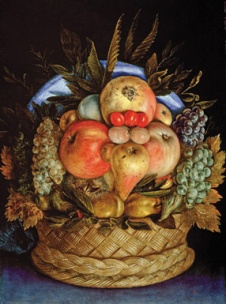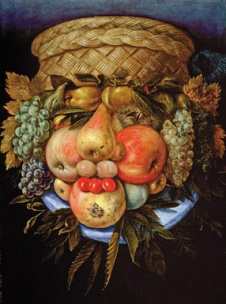 New artist alert: well, actually not so new — hails from the 16th Century, in fact — but you’d be hard-pressed to guess that.
New artist alert: well, actually not so new — hails from the 16th Century, in fact — but you’d be hard-pressed to guess that.
I delved into the background of Giuseppe Arcimboldo (born in 1526 or 1527 in Milan), an Italian iconoclast whose legacy is still surprisingly vibrant and creative, after running across an installation by American artist Philip Haas that’s on display at the New York Botanical Garden throughout this summer. Haas’ 15-feet-tall fiberglass creations are inspired by Arcimboldo’s portraits of the Four Seasons, with faces constructed of such items of nature as fruits, vegetables, and flowers.
What’s neat about Arcimboldo is that the jury is still out on whether his paintings were either products of a quirky sensibility or the fruits (excuse the pun) of a deranged mind. Many consider him to be a Methuselah-like forerunner of what’s now known as Surrealism, which makes his output, that coincides with the strict classicism of the High Renaissance (he’s labeled a Mannerist), seem even more cutting edge for the time.
output, that coincides with the strict classicism of the High Renaissance (he’s labeled a Mannerist), seem even more cutting edge for the time.
Case in point, and a piece I find delightful, is his Reversible Head with a Basket of Fruit, from 1590. What looks like a pretty punnet arrangement at first glance, top, becomes a clever portrait of a human face, right, when turned upside down. With apples for cheeks, and whimsically ringed with grapes and leaves as curls and beard, it brings artistic meaning to the term “organically produced.”
Throughout his years at the court of the Hapsburgs, Arcimboldo didn’t shy away from mocking the monarchs to whom he owed his employ. The Holy Roman Emperor Rudolph II shows up as the ancient god of growth and the seasons, Vertumnus, and his subtle critiques of the upper class  underlie such works as The Librarian.
underlie such works as The Librarian.
It took such artists as Salvador Dalí and the wave of Surrealism that swept contemporary art in the early part of the last century to revive interest in Arcimboldo’s one-of-a-kind imagination. (In another surrealistic twist of his influence on popular culture, his allegorical painting, Water, was the cover of an album by the rock band, Kansas.)
Whether madman or genius, old Arcimboldo definitely met one criteria for what can be considered art in any form: providing a new way to see.

Fabulous.
Always so interesting, captivating information and
beautifully displayed, I love your blog. Please, keep
it coming! Thank you…
loved that fruit basket! reminds of that one with skull at the bottom of the painting, whatever that was called.
I wonder if you’re referring to Cezanne’s “Still Life With Skull”: http://www.wikipaintings.org/en/paul-cezanne/still-life-with-skull-1898
Thanks for writing!